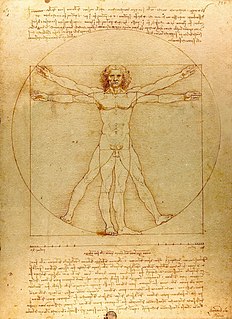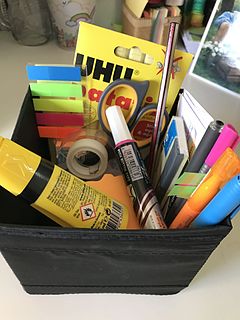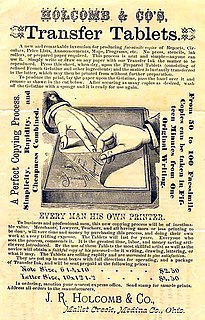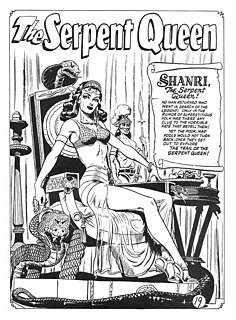
Drawing is a form of visual art in which an artist uses instruments to mark paper or other two-dimensional surface. Drawing instruments include graphite pencils, pen and ink, various kinds of paints, inked brushes, colored pencils, crayons, charcoal, chalk, pastels, erasers, markers, styluses, and metals. Digital drawing is the act of drawing on graphics software in a computer. Common methods of digital drawing include a stylus or finger on a touchscreen device, stylus- or finger-to-touchpad, or in some cases, a mouse. There are many digital art programs and devices.

Parchment is a writing material made from specially prepared untanned skins of animals—primarily sheep, calves, and goats. It has been used as a writing medium for over two millennia. Vellum is a finer quality parchment made from the skins of young animals such as lambs and young calves.

Printmaking is the process of creating artworks by printing, normally on paper, but also on fabric, wood, metal, and other surfaces. "Traditional printmaking" normally covers only the process of creating prints using a hand processed technique, rather than a photographic reproduction of a visual artwork which would be printed using an electronic machine ; however, there is some cross-over between traditional and digital printmaking, including risograph. Except in the case of monotyping, all printmaking processes have the capacity to produce identical multiples of the same artwork, which is called a print. Each print produced is considered an "original" work of art, and is correctly referred to as an "impression", not a "copy". However, impressions can vary considerably, whether intentionally or not. Master printmakers are technicians who are capable of printing identical "impressions" by hand. Historically, many printed images were created as a preparatory study, such as a drawing. A print that copies another work of art, especially a painting, is known as a "reproductive print".

Gouache, body color, or opaque watercolor, is a water-medium paint consisting of natural pigment, water, a binding agent, and sometimes additional inert material. Gouache is designed to be opaque. Gouache has a considerable history, having been used for at least twelve centuries. It is used most consistently by commercial artists for posters, illustrations, comics, and other design work.

A notebook is a book or stack of paper pages that are often ruled and used for purposes such as recording notes or memoranda, other writing, drawing or scrapbooking.

Stationery is a mass noun referring to commercially manufactured writing materials, including cut paper, envelopes, writing implements, continuous form paper, and other office supplies. Stationery includes materials to be written on by hand or by equipment such as computer printers.

Rubber stamping, also called stamping, is a craft in which some type of ink made of dye or pigment is applied to an image or pattern that has been carved, molded, laser engraved or vulcanized, onto a sheet of rubber. The rubber is often mounted onto a more stable object such as a wood, brick or an acrylic block. Increasingly the vulcanized rubber image with an adhesive foam backing is attached to a cling vinyl sheet which allows it to be used with an acrylic handle for support. These cling rubber stamps can be stored in a smaller amount of space and typically cost less than the wood mounted versions. They can also be positioned with a greater amount of accuracy due to the stamper's ability to see through the handle being used. Temporary stamps with simple designs can be carved from a potato. The ink-coated rubber stamp is pressed onto any type of medium such that the colored image is transferred to the medium. The medium is generally some type of fabric or paper. Other media used are wood, metal, glass, plastic, and rock. High-volume batik uses liquid wax instead of ink on a metal stamp.

A perforation is a small hole in a thin material or web. There is usually more than one perforation in an organized fashion, where all of the holes collectively are called a perforation. The process of creating perforations is called perforating, which involves puncturing the workpiece with a tool.

The hectograph, gelatin duplicator or jellygraph is a printing process that involves transfer of an original, prepared with special inks, to a pan of gelatin or a gelatin pad pulled tight on a metal frame.

Quilling or paper filigree is an art form that involves the use of strips of paper that are rolled, shaped, and glued together to create decorative designs. The paper is rolled, looped, curled, twisted, and otherwise manipulated to create shapes that make up designs to decorate greetings cards, pictures, boxes, eggs, and to make models, jewelry, mobiles, etc. Quilling starts with rolling a strip of paper into a coil and then pinching the coil into shapes that can be glued together. There are advanced techniques and different sized paper that are used to create 3D miniatures, abstract art, flowers, and portraits among many things.

In comics, a colorist is responsible for adding color to black-and-white line art. For most of the 20th century this was done using brushes and dyes which were then used as guides to produce the printing plates. Since the late 20th century it is most often done using digital media, with printing separations produced electronically.

Scratchboard or scraperboard, is a form of direct engraving where the artist scratches off dark ink to reveal a white or colored layer beneath. Scratchboard refers to both a fine-art medium, and an illustrative technique using sharp knives and tools for engraving into a thin layer of white China clay that is coated with dark, often black India ink. There is also foil paper covered with black ink that, when scratched, exposes the shiny surface beneath. Scratchboard can be used to yield highly detailed, precise and evenly textured artwork. Works can be left black and white, or colored.

A wash is a term for a visual arts technique resulting in a semi-transparent layer of colour. A wash of diluted ink or watercolor paint applied in combination with drawing is called pen and wash, wash drawing, or ink and wash. Normally only one or two colours of wash are used; if more colours are used the result is likely to be classified as a full watercolor painting.

Leather crafting or simply leathercraft is the practice of making leather into craft objects or works of art, using shaping techniques, coloring techniques or both.

Cake decorating is one of the sugar arts that uses icing or frosting and other edible decorative elements to make plain cakes more visually interesting. Alternatively, cakes can be molded and sculpted to resemble three-dimensional persons, places and things.
Scribing was used to produce lines for cartographic map compilations before the use of computer-based geographic information systems. Lines produced by manual scribing are sharp, clear and even.

Drafting tools may be used for measurement and layout of drawings, or to improve the consistency and speed of creation of standard drawing elements. Tools such as pens and pencils mark the drawing medium. Other tools such as straight edges, assist the operator in drawing straight lines, or assist the operator in drawing complicated shapes repeatedly. Various scales and the protractor are used to measure the lengths of lines and angles, allowing accurate scale drawing to be carried out. The compass is used to draw arcs and circles. A drawing board was used to hold the drawing media in place; later boards included drafting machines that sped the layout of straight lines and angles. Tools such as templates and lettering guides assisted in the drawing of repetitive elements such as circles, ellipses, schematic symbols and text. Other auxiliary tools were used for special drawing purposes or for functions related to the preparation and revision of drawings. The tools used for manual technical drawing have been displaced by the advent of computer-aided drawing, drafting and design (CADD).
The following outline is provided as an overview of and typical guide to drawing and drawings:

Stipple engraving is a technique used to create tone in an intaglio print by distributing a pattern of dots of various sizes and densities across the image. The pattern is created on the printing plate either in engraving by gouging out the dots with a burin, or through an etching process. Stippling was used as an adjunct to conventional line engraving and etching for over two centuries, before being developed as a distinct technique in the mid-18th century.

















